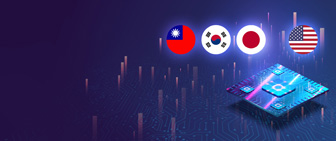Taiwan's smartphone market is expected to face another challenging year in 2026, as rising device prices, extended replacement cycles, and persistent memory supply constraints limit shipment growth, even as higher average selling prices support revenue expansion.
Taiwan's leading telecom operators are entering the second phase of 5G deployment, as the focus turns toward improved network experiences to drive user adoption.
Samsung Electronics has reportedly become the largest supplier of mobile DRAM for Apple's iPhone 17, a trend expected to continue with the upcoming iPhone 18. Industry analysts attribute this shift to SK Hynix and Micron recently focusing their production capacity on AI-targeted high-bandwidth memory (HBM), prompting Apple to rely more heavily on Samsung's ample general DRAM output to secure supply.
Despite approaching the end of the year and the promotional peak season coming to an end, overall utilization rates in the smartphone panel market have remained relatively high. Additionally, differences in market conditions and structures among panel technologies have led to mixed price movements.
Apple has confirmed it will release a new generation of Siri in 2026, marking a major software update and a renewed effort to compete in the artificial intelligence (AI) sector. The move follows a cautious approach by Apple compared to faster developments by competitors.
Taiwan-based networking solutions provider Zinwell Corp reported a dramatic revenue rebound, with September 2025 sales soaring 216.6% year-over-year and accelerating to 319.8% in October. The company credited the surge to successful product validations and a shift toward mass production for major international clients.
Samsung Electronics launched its first tri-fold smartphone, the Galaxy Z TriFold, in Taiwan on December 18. The company announced on December 19 that the entire initial shipment had sold out on launch day.
Apple's iPhone 17 series has achieved strong sales following its September 10 launch, with the standard iPhone 17 maintaining its price despite upgraded specifications. This contributed to sales initially surpassing expectations and sustaining momentum through October, leading the iPhone 17 to capture over 20% of the market share in China during that month.
The global telecommunications equipment market is entering a period of profound change. As the technological roadmap for 6G increasingly points toward non-terrestrial networks, or NTN, the future of base stations may no longer be grounded on Earth. Instead, they could be deployed in space, mounted directly on satellites.
Apple is poised to surpass Samsung Electronics in global smartphone shipments in 2025, marking its first return to the top spot in 14 years. Meanwhile, Samsung's smartphone business, once a key revenue pillar during downturns in its semiconductor division, is reportedly showing signs of strain amid rising costs and intensifying competition.
According to Yonhap News and The Korea Herald, Samsung Electronics has posted a full specification sheet for its mobile application processor (AP), the Exynos 2600, on its official website. The Exynos 2600 was designed by Samsung Semiconductor's Device Solutions (DS) division under the System LSI business unit and manufactured using the company's most advanced 2nm process based on Gate-All-Around (GAA) technology. With the specifications now public, the industry's first 2nm mobile AP is expected to attract increased attention from the tech sector.
More coverage



